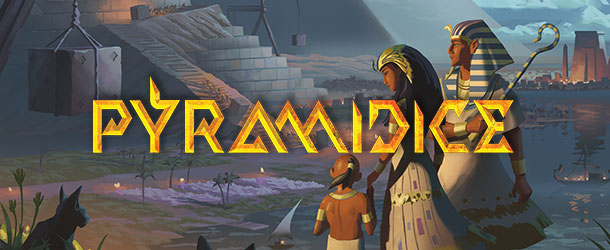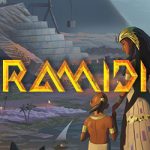Pyramidice, the game of dice and card combos set in Ancient Egypt, focuses on the construction of the Pyramids on the Giza plateau and on the worship of the ancient Gods. Players assume the roles as ancient architects of great Egypt called upon to vie for the Pharaoh's respect through the construction of majestic pyramids. But It’s not all about engineering and labor: they will need the favor of the Gods, and choose the right deities to address their prayers to safeguard their legacy. The game mechanics are well tied to the theme, and the setting reveals a great attention to historical details. In this series of articles, we delve into the Gods, the Pyramids, and the Architects featured in Pyramidice, with the support of the historical consultant prof. Marco Mengoli, who collaborated with the development team. Let’s start with the Gods.
Egypt had one of the largest and most complex pantheons of gods of any civilization in the ancient world. Over the course of Egyptian history hundreds of gods and goddesses were worshipped, as each city/area had their own deities, and the number of deities was large and not fixed. New ones appeared, and some ceased to be worshipped.
Pyramidice presents 38 Egyptian deities, each with their own characteristics. For the names of the Gods, which are called in different ways depending on the language, the choice was to use the Greek form in the game – the first found in historical sources. Most of the 38 Gods have in-game effects, related to their characteristics, while 11 have no effect during the game, but can be worth fame points at the end.
The Ennead is a group of 9 Gods worshipped at Heliopolis, the City of the Sun, believed to be central to the creation of the world in ancient times. The earliest god, Atum emerged from a chaotic state of the world and gave rise to Shu (air) and Tefnut (moisture - air, dew, and rain), from whose union came Geb (earth) and Nut (sky), who in turn created Osiris (under world, fertility, and regeneration), Isis (motherhood), Seth (chaos), and Nephthys (protection).
Regarding Geb and Nut, it’s interesting to notice that differently from the Greeks and other civilizations, where we have an earth-goddess and a sky-god, in Egypt the genders are swapped. The goddess is usually the one who “gives birth” to something (usually plant life) with the rain being the seed which fructifies Mother Earth – so the Sky is personified as masculine. In Egypt, however, there is no rain, and the fertility is due to the water on the earth (from the Nile River). As the goddess of the sky, Nut swallowed the sun in the evening and gave birth to it again in the morning - the most vital thing that is born is the most important deity: the sun god Ra.
An extension to the Ennead framework was the Osiris myth - involving Osiris, his consort Isis, and their son Horus, magically conceived after the murder of Osiris by his brother Seth. Depicted as a falcon or as a man with a falcon’s head, Horus was a sky god associated with war and hunting. He was also the embodiment of the divine kingship, and in some eras the reigning king was considered to be a manifestation of Horus.
The 9 Ennead Gods and Horus are together in a set of cards to collect: they count as one single God when in front of you, and at the end of the game, they give you Fame points according to the number of Ennead cards you own, from 0 for one card to 42 for seven or more.
The Egyptian pantheon presents several triads, groups of three gods, usually organized into a family of father, mother and child. Triads also reflect the comprehensiveness of the gods - in Egyptian 'three' also means 'plural'. In Pyramidice, the Elephantine Triad is represented: Khnum, Satis, and Anuket - father, mother and daughter, creator, and protector Gods of the Nile’s floods. Worshipped at the great temple at Elephantine, an island in the upper Nile, they are associated with fertility and procreation. Khnum was one of the earliest-known Egyptian deities in Upper Egypt, originally associated with the Nile cataract and the regulation of the annual inundation of the river. He was considered the creator of men, shaping them on his potter's wheel from clay, much like the God of the Old Testament. Satis was revered as goddess of fertility, war, and hunting, and Anuket was worshipped as the great nourisher of the farms and fields. Their God cards provide players with an extra virtual Prayer die with one of the two values shown in the card.
Gods of other triads are present in the game, but individually, with different effects. From the Memphis triad, we have Ptah and Sekhmet. God creator of the universe, Ptah is patron God of craftsmen and architects, and God of learning and knowledge. He allows players to restore all the cards activated in the current Work turn and worths 2 Fame points at the end of the game. Sekhmet is Goddess of war, of epidemics and healings, her breath was believed to generate the desert.
Sekhmet is the starring character of the Egyptian version of the Flood myth: she is sent to Earth to destroy the entire human race, but the gods repent their decision and choose to stop her using a flood of red-painted beer to look like blood; the goddess (known as the “blood drinker”) drinks it all, get plastered and is taken away from surviving people. In Egypt the Flood is made of beer and not of water, and saves the humans instead of destroying them. In the game, players must renounce to resources (Worker, Cat, and Stone) to gain 7 Fame points.
The Triad of Thebes consisted of Amon, his consort Mut and son, Khonsu. Thebes is the Greek name for a city in Upper Egypt on the east bank of the river Nile (now Luxor and Karnak). Amon is the Creator god, transcendent, self-created; considered the King of the Gods. Originally one of the eight deities of the Hermopolite creation myth, his cult reached Thebes. By the reign of Mentuhotep I (2008–1957 BCE), Amon was already identified with the sun god Re of Heliopolis and, as Amon-Re, was worshipped as part of the Theban triad, with the sky goddess and great divine mother Mut - the mother from whom the world originated, and Khonsu, God of the moon and of youth - his name means 'traveler', which may relate to the perceived nightly travel of the Moon across the sky, and he marked the passage of time.
For a short period of time, the sun god Aton was worshipped as supreme divinity in Egypt religion, at the behest of the pharaoh Akhenaton (1353–36 BCE) to replace the preeminent cult of the Theban Amon. Completely distinct of other deities, Aton was depicted as the solar disk emitting rays terminating in human hands, and was to be the only god - some scholars consider him the first case of monotheism in history. Akhenaton built the city Akhetaton (now Tell el-Amarna) as the center for the Aton’s worship. In the game, the player may discard one of its other god cards to gain 4 Fame points.
Among the 27 cards that have effects in the game, only two are used in the Rest turns – all the others can be activate only in the Work turns. Bes is the protector god of home, sleep, and marriage. Represented as a dwarf with large head and usually a crown of feathers, with a somehow grotesque figure, he was also deemed for scaring away evil spirits. In the game, his card gives one Fame point in a Rest turn.
Hapy, or Hapi, was the embodiment of fertility and earth’s prosperity due to the flooding of the Nile. Called "Lord of the Fish and Birds of the Marshes" and "Lord of the River Bringing Vegetation", he was depicted as an androgynous figure with a prominent belly, swelling and drooping breasts, dressed in a belt suitable to a marsh dweller or servant. His effect in the game is to increase the resources – discarding one resource of any type (Worker, Cat, or Stone), you can take three resources different from the one discarded.
Information sources: Britannica, Wikipedia.













